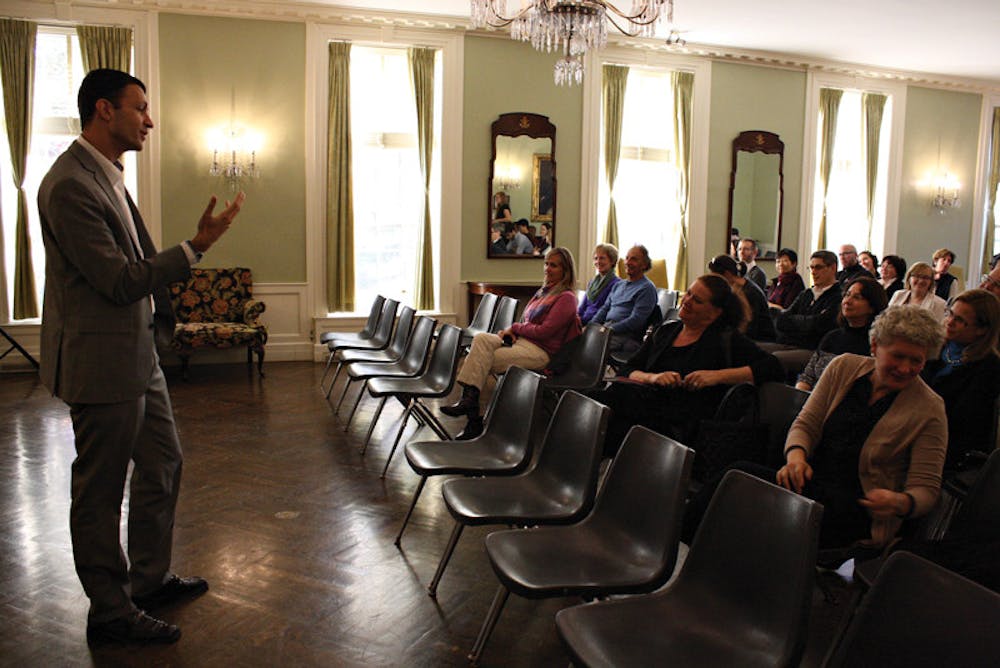Exploding magic tricks in the middle of an elementary school classroom and daily rounds of chess with Janitor Jim marked a journey governed by dyslexia and attention deficit hyperactivity disorder for David Flink ’02.
As part of the Swearer Center for Public Service’s Social Innovation Initiative, Flink shared fragments of his childhood journey in Alumnae Hall’s Crystal Room Monday, during which he introduced his new book, “Thinking Differently,” and discussed Eye to Eye, a program that matches school-aged children with learning disabilities with college student mentors with learning disabilities.
Flink exuded an energy uncontainable by his gray suit and the old portraits that surrounded him, speaking with a steady humor that matched his restless pacing. Instead of beginning his hour-long talk with the trials he faced in order to co-found and rise to chief executive officer of Eye to Eye — one of the leading nonprofit mentoring programs in the country — Flink opened by asking, “What is the potential in thinking differently?”
Flink co-founded Eye to Eye in 1998 with four other Brown students. The program operates on the belief that learning disabilities are new avenues of thinking, not academic setbacks.
Flink was not diagnosed with learning disabilities during his early elementary school years. Rather, he was stamped with different labels, progressing from “lazy” to “stupid” and finally “troublemaker.” A regular at the principal’s office, Flink constantly endured lectures pushing him to try harder, Flink said. “Trying harder when you’re dyslexic was like being in a wheelchair and trying to get up the stairs. I didn’t have a ramp.”
Three main experiences pulled Flink out of the rut of discouragement. The first was with Janitor Jim, who befriended him as he sat banished from class in the hallways and always let him win at chess. The second encounter was when his normally impatient father recorded himself reading an entire science textbook so Flink could better absorb the material. Finally, his family made the enormous financial sacrifice of buying him a laptop, which carried the secret weapon of a dyslexic student: spell check. Though these gestures helped Flink achieve better success at school, their true function was to boost Flink’s flagging self-esteem as symbols of support, he said.
Loneliness is one of the major detriments of the stigma associated with learning disabilities, Flink told The Herald. “It takes a toll on your soul.”
Eye to Eye eliminates this stigma and converts students’ talents into valuable assets, said Maureen Kenner, special education teacher at Vartan Gregorian Elementary School and faculty coordinator for Eye to Eye’s Brown chapter. Working in special education for 35 years has allowed her to appreciate how Eye to Eye fostered an organic, creative environment for students, she said.
After Flink graduated, word about Eye to Eye spread and new chapters began to erupt at other schools. In response to this growth, he quit his job at the Brown Admission Office to build a unified Eye to Eye community, he told The Herald.
With Eye to Eye’s rapid expansion to 56 chapters, which collectively mentor thousands of students, the program’s hopes have likewise grown. Though mentoring remains the core of Eye to Eye’s program, Flink said he ultimately aims to change the entire culture surrounding learning disabilities, creating a “coalition of young people who can say that (they) deserve to be taught in the best possible way.”
Because each mentor has also struggled with their learning disability, they understand the challenges that their mentees currently face. “If you’re dyslexic, you know exactly what this kid needs because you’ve actually been there,” Flink told The Herald.
Madeleine Slater ’17, a mentor at Brown’s chapter of Eye to Eye, said she did not realize she had a learning disability until she was 12 years old. Though she did well in school, she had to invest much more time to read and understand material than her peers did. Upon learning of her disability, Slater said she was able to qualify for extra time on tests, which drastically improved her ability to do well in school. “I want kids to know that they have just as much power as everyone else,” Slater said.
“It’s a great way for me to explore the role (my learning disability) occupies in my own life, but also other students’ lives, said Cassidy Wald ’17, co-head of Eye to Eye at Brown. Talking to her mentee, who she said brims with energy and a love of learning, reminds her to reflect on her own experiences that are easily forgotten in the thick of her busy schedule.
Over the years, Eye to Eye’s curriculum has evolved through the ideas of student groups across different campuses, Flink said. Today, the program focuses on the personal relationships between young students and their mentors, and encourages the mentees to cultivate a powerful self-image. “They need to find a language to describe how they learn, to describe what tools they need to overcome weaknesses.”
Rather than treating learning disabilities as disorders that need fixing, Eye to Eye instead seeks to celebrate them as distinctive traits.
“It’s not the most well-understood phenomenon,” Wald said. For example, other students comment on how “lucky” she is to receive extra time on tests and assignments. Eye to Eye, she said, has taught her to embrace her dyslexia.
“It’s kind of taboo to talk about it,” Slater said. “Most people don’t even know I have a learning disability.”
Slater said students of all learning styles should push through their discomfort in discussing it. By spreading awareness about learning disabilities, Eye to Eye aims to promote a more open culture of self-acceptance. “It’s part of who I am,” Slater said.

ADVERTISEMENT




